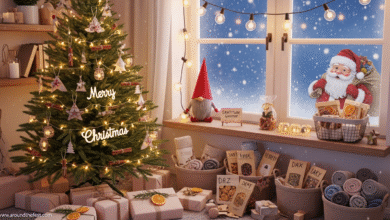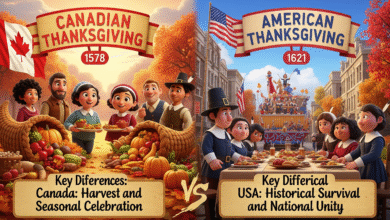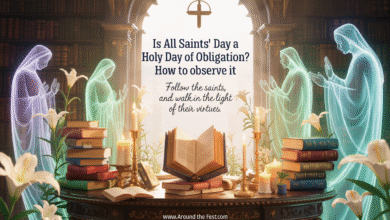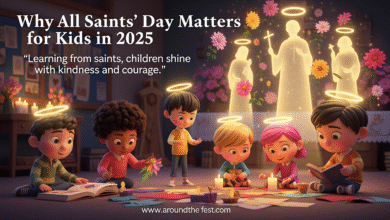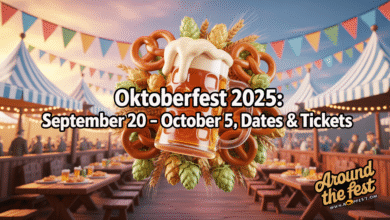Does Halloween Have a Dark Meaning? History, Symbols ,Origins
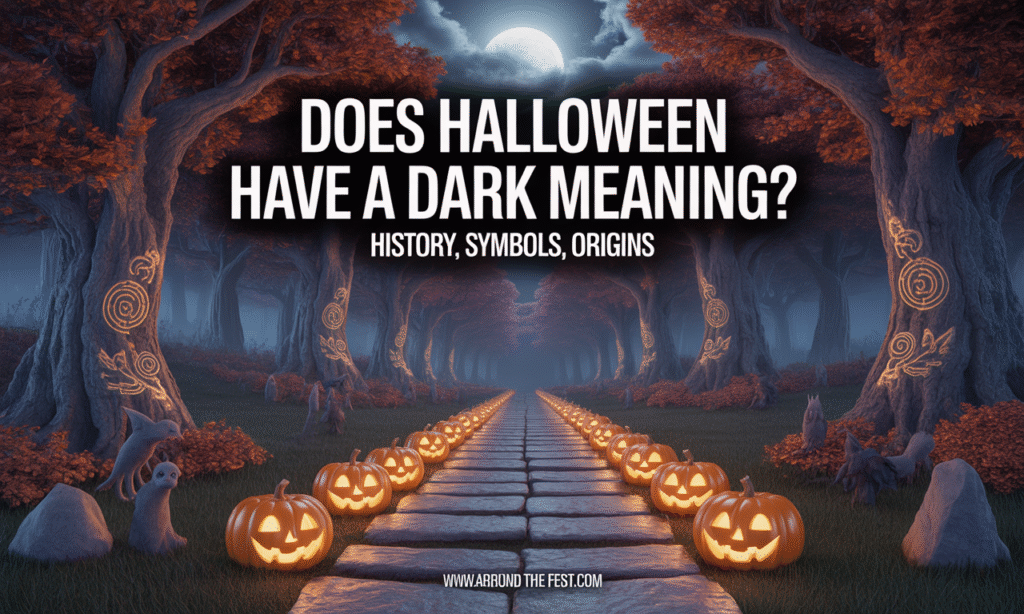
Does Halloween Have a Dark Meaning? Introduction to Its Spooky Roots
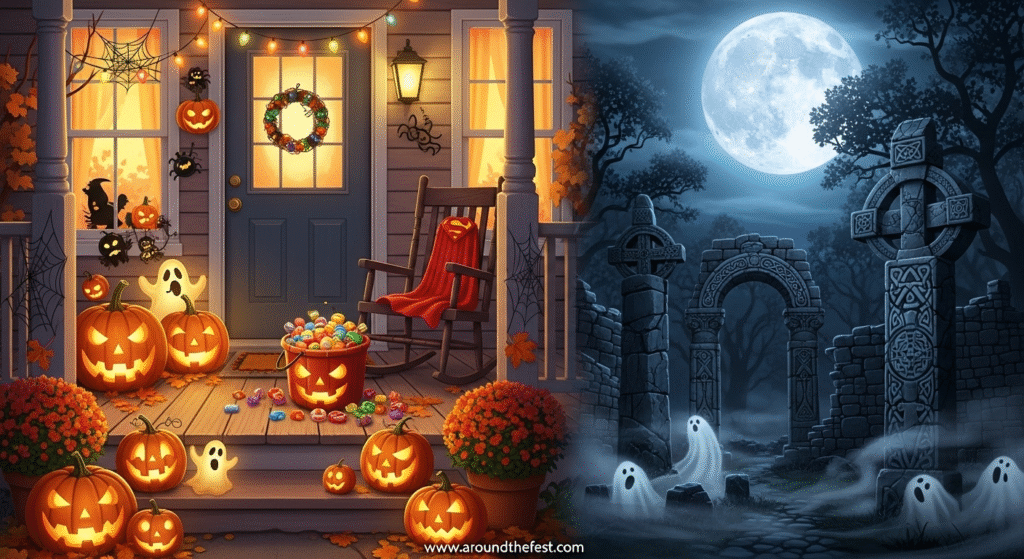 According to Google Trends, searches for terms like “Is Halloween evil?”, “what does Halloween really mean”, and “dark origin of Halloween” surged in October 2024.
According to Google Trends, searches for terms like “Is Halloween evil?”, “what does Halloween really mean”, and “dark origin of Halloween” surged in October 2024.
The renewed interest reveals growing curiosity around Halloween’s true nature.
While today’s celebrations seem playful—ghost cookies, carved pumpkins, superhero costumes—many symbols trace back to ancient Celtic Samhain rituals, where people honored the dead and feared the spirits crossing into our world.
For some, Halloween is nostalgic and creative. For others—particularly in religious circles—it raises concerns about occult themes, spiritual confusion, or anti-Christian elements. Some families and schools even choose not to celebrate.
In October 2024, The Guardian covered a UK vicar’s controversial Halloween service involving “witches and vampires.” The story sparked heated debates online—from Reddit threads to TikTok videos—about Halloween’s deeper meaning.
So, what does Halloween really mean in 2025—lighthearted tradition or something more spiritually complex?
In this post, we’ll explore Halloween’s pagan roots, spiritual symbolism, and why the debate over its meaning still matters today.
The Pagan Roots of Halloween’s Dark Meaning – Samhain Origins
Long before Halloween meant candy and costumes, it marked a spiritual turning point.
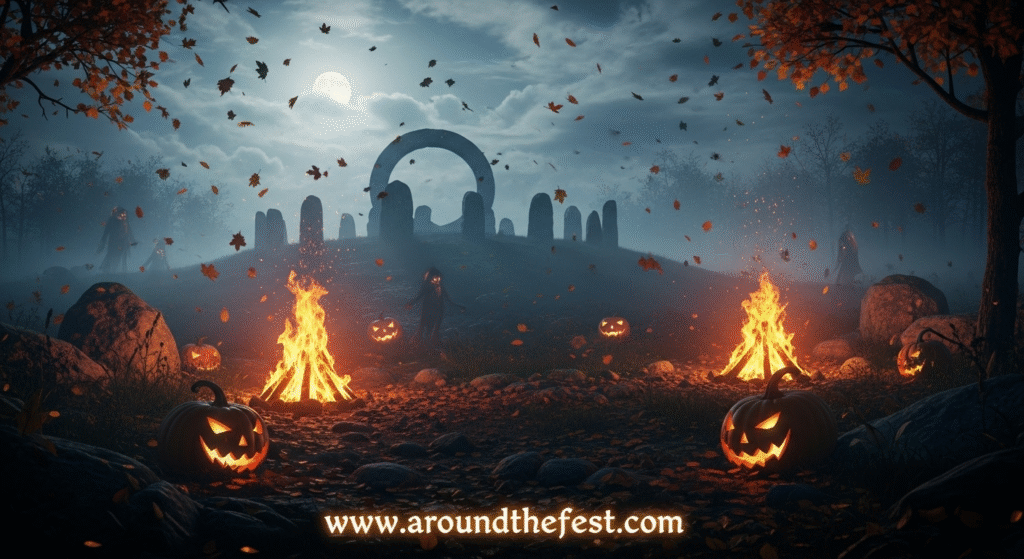
Halloween’s ancient roots go back to Samhain, a Celtic festival where people believed the veil between the living and the dead grew thin—so thin that spirits could cross over into our world.
It wasn’t just about ghosts; it was a deeply spiritual time to honor ancestors, light protective bonfires, and prepare for the darker half of the year. This eerie, mystical origin still echoes through many of today’s Halloween traditions.
This dark origin of Halloween shaped many of today’s most familiar customs—from disguises to jack-o’-lanterns.
What Is Samhain—Why Is It Halloween’s Spiritual Grandparent?
Does Halloween have a dark meaning? To understand it, we need to trace Halloween back to its earliest roots—Samhain (pronounced “Sow-in”).
This Celtic festival, celebrated over 2,000 years ago in Ireland, Scotland, and Wales, marked the end of harvest and the beginning of winter’s dark season.
For the Celts, Samhain wasn’t just the end of harvest—it was the year’s most powerful turning point, when the boundary between this world and the next faded into mist.”
Spirits, ancestors, and otherworldly beings could move between worlds.
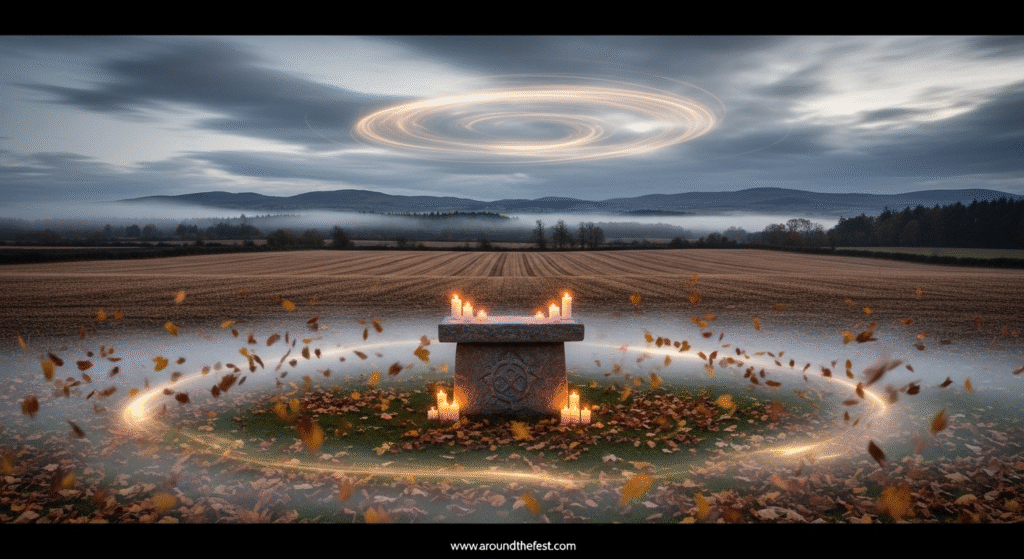 Today’s Halloween may look like candy bowls and plastic pumpkins, but its pagan foundation lies in this mystical and transitional celebration.
Today’s Halloween may look like candy bowls and plastic pumpkins, but its pagan foundation lies in this mystical and transitional celebration.
Key Insight: Unlike modern Halloween’s playful vibe, Samhain held sacred meaning. The Celts didn’t fear death. Instead, they viewed it as a natural transformation, much like leaves falling to prepare the land for winter.
When, Where, Why & How Was Samhain Celebrated?
“With every falling leaf, Samhain echoed a truth the Celts knew well: that life and loss dance in the same cycle”. Samhain rituals reflected deep reverence for life, death, and nature’s rhythm.
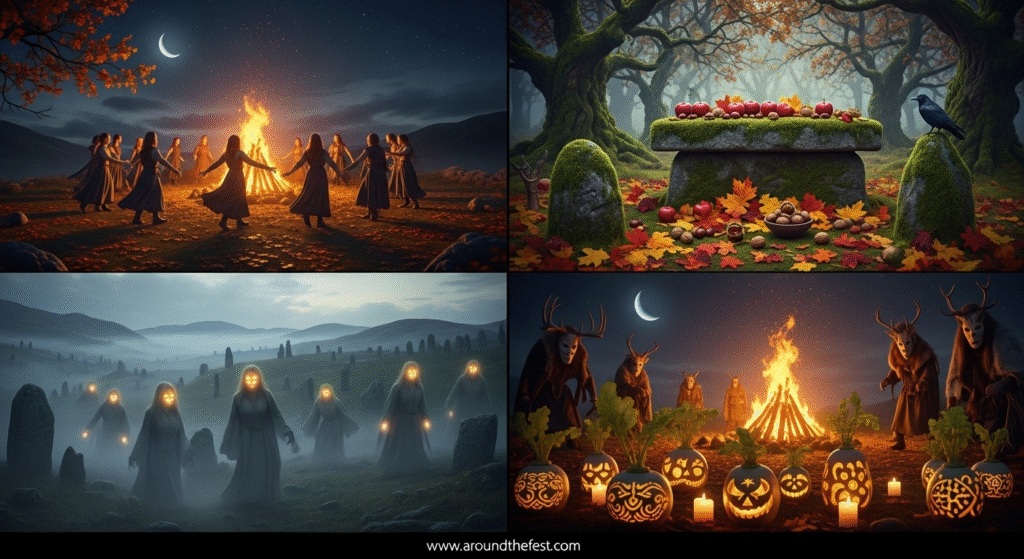 When: “Samhain: the sacred Celtic New Year, spanning October 31 to November 1, when time itself felt suspended.”
When: “Samhain: the sacred Celtic New Year, spanning October 31 to November 1, when time itself felt suspended.”
Where: Ancient Celtic regions across the British Isles
Why: “Part ritual, part reflection—this was the moment to thank the past and prepare the spirit for winter’s descent.”
How:
People lit bonfires to guide lost souls and protect their homes
“Dressing in animal hides wasn’t about style—it was a survival ritual to stay hidden from wandering souls.”
Families left offerings of food to welcome ancestral visitors
“Simple harvest foods like apples and nuts became magical tools for predicting romance, luck, and life’s path.”
These weren’t rituals of fear. They were attempts to bring balance between light and dark, life and death.
Transitioning from Sacred to Seasonal: Samhain’s Lingering Influence
 These aren’t just quirky seasonal habits—they echo a spiritual worldview that saw October 31 as a moment of spiritual crossing.
These aren’t just quirky seasonal habits—they echo a spiritual worldview that saw October 31 as a moment of spiritual crossing.
Samhain as a Natural Death Marker
While many blogs focus on witches or ghosts, they often miss why Samhain happened when it did. This wasn’t a random date—it aligned with the natural world’s own cycle of death and renewal.
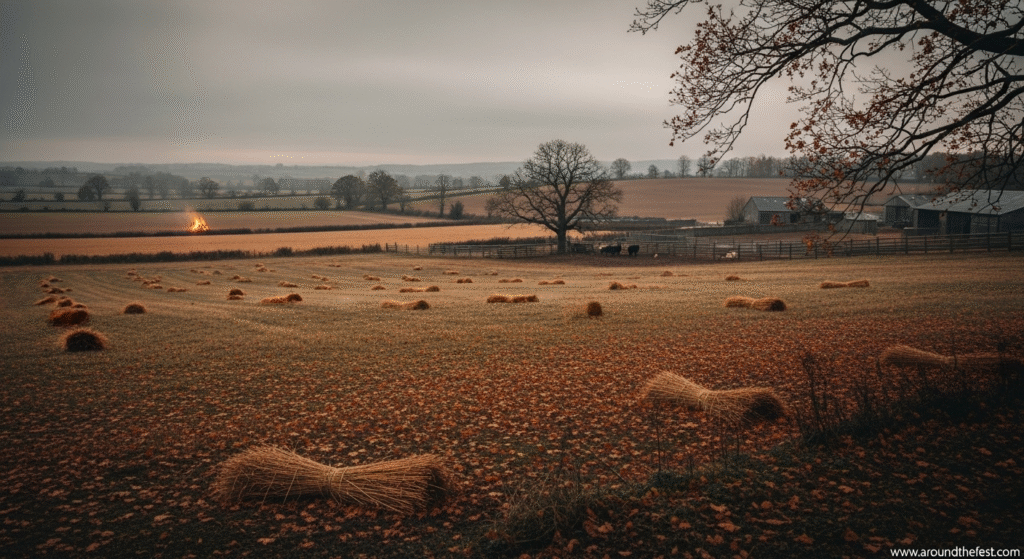 End of harvest: Fields were bare, and livestock were culled
End of harvest: Fields were bare, and livestock were culled
Longer nights: Darkness returned, symbolizing introspection and mortality.
Spiritual reset: “In the stillness between harvest and winter, ancient cultures found time to reset their spirits and reconnect with purpose.”
This cycle gave Halloween its spiritual meaning—a recognition that all things die, and that death itself is part of life’s rhythm. Sadly, this deeper symbolism often gets lost beneath commercial Halloween traditions.
Samhain’s 2025 Revival: From Ancient Bonfires to #WitchTok
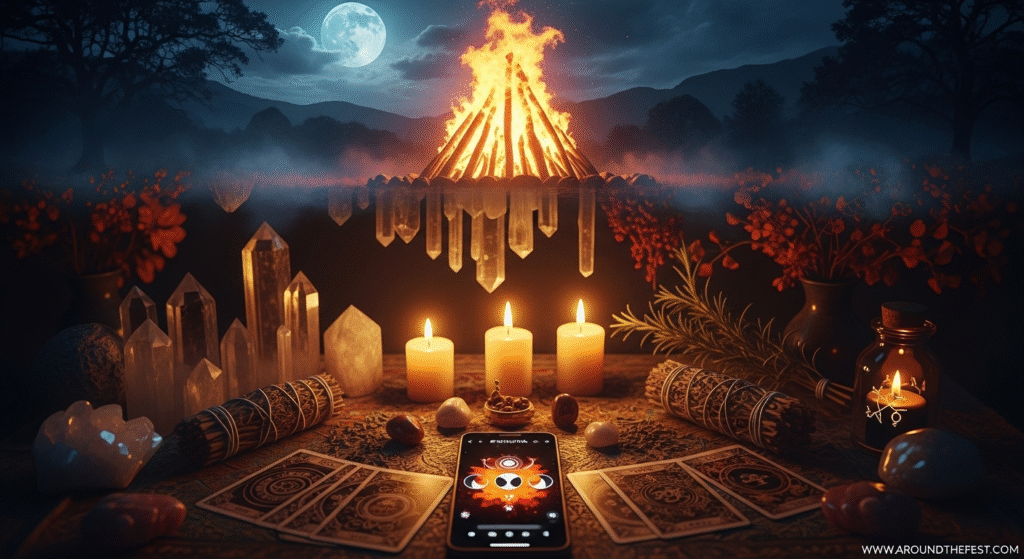 In 2025, Samhain isn’t just folklore—it’s a rising trend. In 2024, TikTok exploded with hashtags like #SamhainRituals and #WitchTok, racking up millions of views. Young people—especially Gen Z and Millennials—are reconnecting with ancient traditions as they explore spiritual wellness and seasonal living.
In 2025, Samhain isn’t just folklore—it’s a rising trend. In 2024, TikTok exploded with hashtags like #SamhainRituals and #WitchTok, racking up millions of views. Young people—especially Gen Z and Millennials—are reconnecting with ancient traditions as they explore spiritual wellness and seasonal living.
Why now? After the pandemic and amid global uncertainty, many crave rituals that offer deeper meaning.
Samhain helps people:
Reconnect with their roots
Acknowledge grief and change
Embrace renewal and spiritual grounding
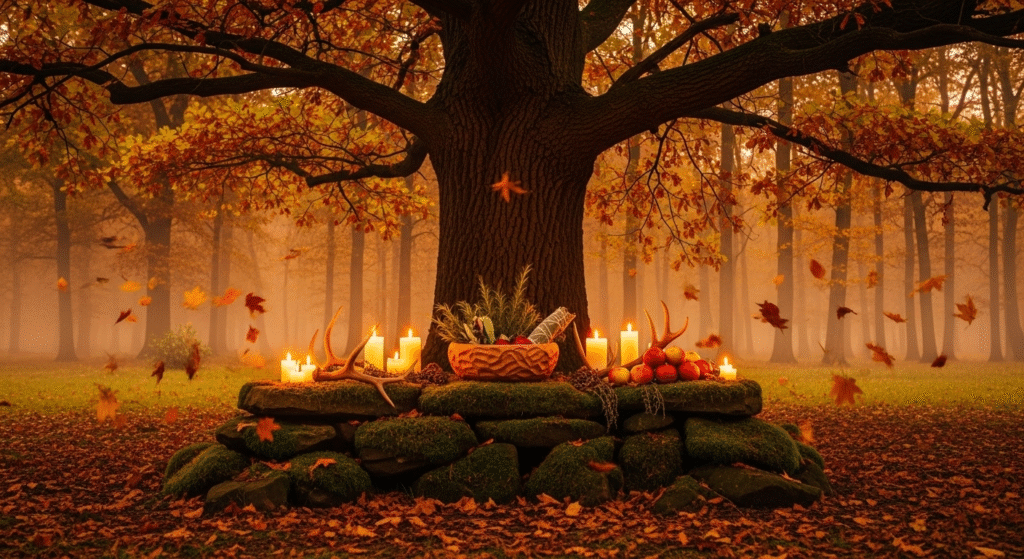 Even TIME Magazine highlighted this in its 2024 cultural trends report, noting increased interest in “death-positive holidays” like Samhain.
Even TIME Magazine highlighted this in its 2024 cultural trends report, noting increased interest in “death-positive holidays” like Samhain.
In 2025, the spiritual meaning of Halloween—as rooted in Samhain—is more relevant than ever. It offers clarity, connection, and comfort in chaotic times.
From Pagan to Pious – How Halloween’s Dark Meaning Shifted with Christianity
While the dark origin of Halloween began with Samhain, the festival didn’t stay purely Celtic for long. As the Roman Empire expanded across Europe, it absorbed local spiritual traditions—including Samhain—blending them with its own rituals for the dead and seasonal deities.
 Roman Layering: Feralia and Pomona
Roman Layering: Feralia and Pomona
Two Roman festivals in particular influenced Samhain’s transformation:
“Feralia, observed in late October, was a Roman rite devoted to honoring the dead through solemn rituals and offerings.”
Pomona (November 1): A harvest celebration devoted to Pomona, goddess of fruit and orchards.

You might recognize Pomona’s influence in the Halloween tradition of bobbing for apples, which wasn’t just fun—it was a form of love divination believed to be blessed by the goddess.
Learn more about Pomona’s role in Roman mythology from World History Encyclopedia
From Pagan to Pious: The Church’s Strategy
By the 7th and 8th centuries, as Christianity gained control across Europe, Church leaders faced a dilemma: how to deal with long-standing pagan holidays like Samhain.
Instead of banning it, they cleverly rebranded it.
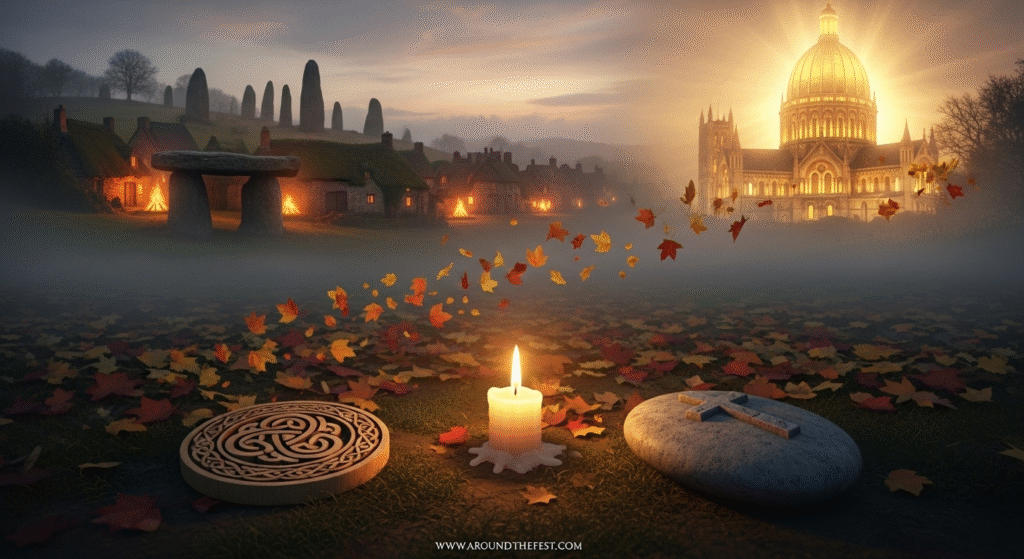
“November 1 was chosen by Pope Boniface IV as All Saints’ Day, part of the Church’s effort to replace ancient festivals with Christian meaning.”
“Over time, All Hallows’ Eve—marked on October 31—merged Christian meaning with earlier folk customs to become the Halloween we know today.”
This move wasn’t just theological—it was tactical. The Church repurposed local rituals and gave them Christian meaning to convert people without alienating their culture.
Rituals Remixed: How Old Customs Persisted
Even as the Church promoted new religious interpretations, the old rituals survived—just in new costumes, literally and figuratively.
People still wore disguises, now saying they honored saints or avoided demons.
They lit candles and offered food—not to spirits, but in memory of the dead.
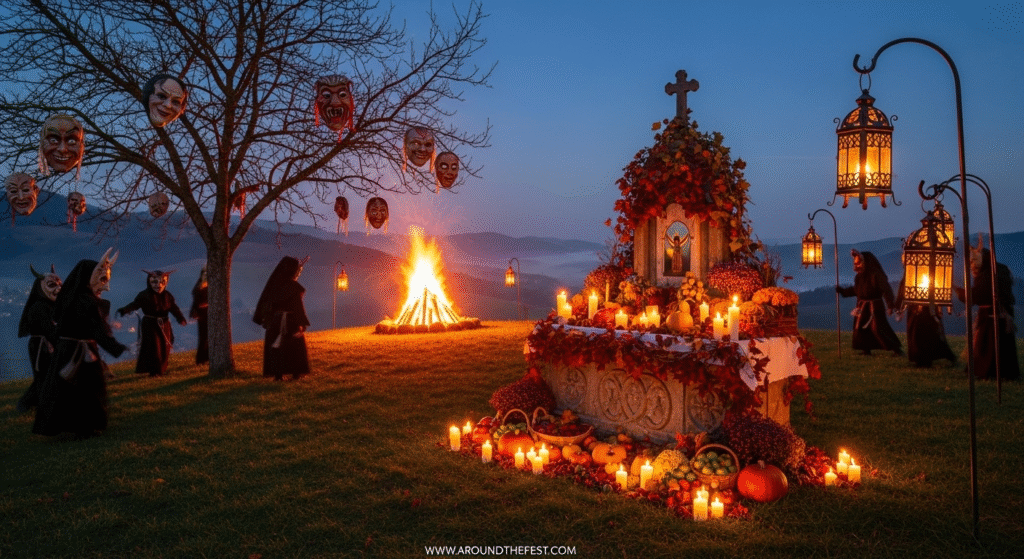 Bonfires remained, symbolizing light over darkness.
Bonfires remained, symbolizing light over darkness.
It was a hybrid holiday, fusing sacred and seasonal themes.
Many believe that this fusion blurred the lines between superstition and sanctity—giving Halloween its unique tension between fun and fear, light and shadow.
The Origin of Trick-or-Treating: “Souling”
An often-missed detail in the dark origin of Halloween is the medieval Christian tradition of souling.
Here’s how it worked:
On All Souls’ Day (Nov 2), the poor would go door-to-door asking for “soul cakes” in exchange for prayers for the dead.
Children sometimes did the same, reciting verses or songs to earn treats.
This spiritual exchange helped souls move from purgatory to heaven, in theory.
Sound familiar? That’s because souling is the direct ancestor of modern trick-or-treating
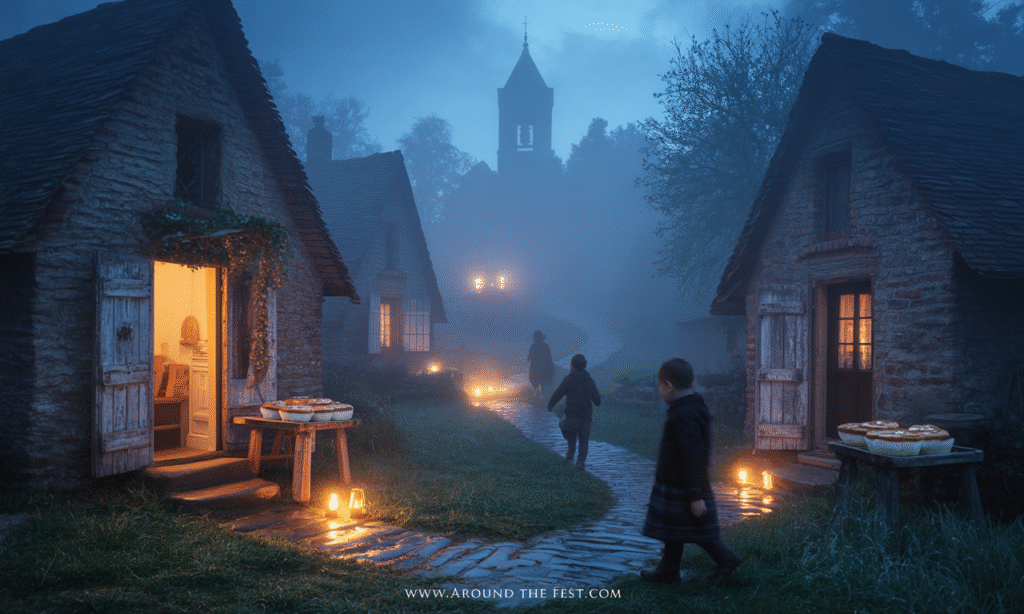 The Role of Power & Politics
The Role of Power & Politics
Rather than eliminate it, the early Church repurposed Halloween to integrate and influence existing cultural belief systems.”
This allowed Christianity to spread without direct conflict.
It also shifted fear of wandering spirits into reverence for saints and martyrs—turning folk magic into Church ritual.
How Halloween’s Dark Meaning Evolved in America – From Fear to Fun
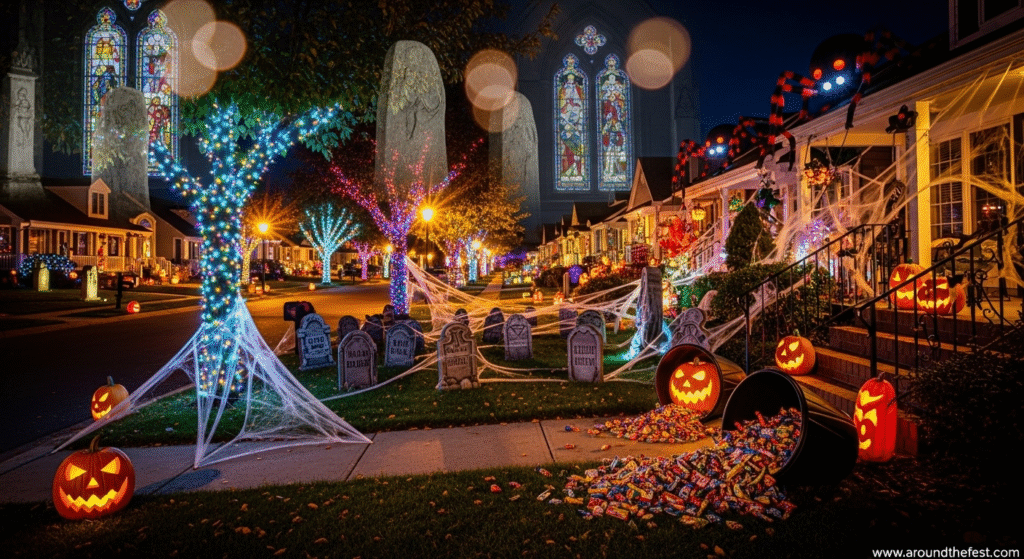 The dark origin of Halloween, rooted in ancient Celtic spirituality and medieval Christian adaptation, underwent its boldest transformation in America. What began as a sacred night of spirits and saints became a multi-billion-dollar industry filled with candy, costumes, and yard inflatables.
The dark origin of Halloween, rooted in ancient Celtic spirituality and medieval Christian adaptation, underwent its boldest transformation in America. What began as a sacred night of spirits and saints became a multi-billion-dollar industry filled with candy, costumes, and yard inflatables.
How Halloween Crossed the Atlantic
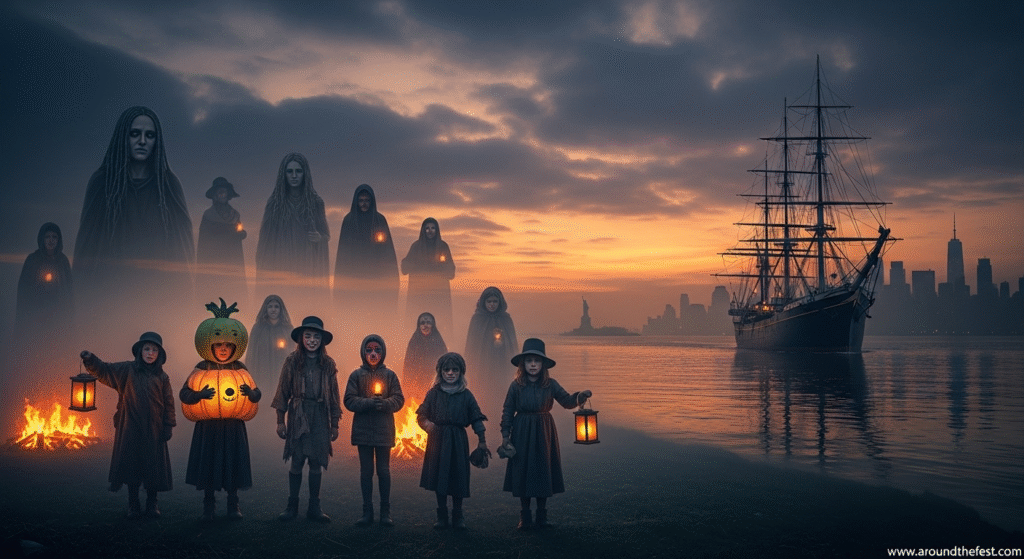 “Fleeing hardship in the 1800s, Irish and Scottish immigrants carried Samhain-based customs across the Atlantic—shaping the Halloween celebrations we know in America today.”
“Fleeing hardship in the 1800s, Irish and Scottish immigrants carried Samhain-based customs across the Atlantic—shaping the Halloween celebrations we know in America today.”
“Guising” — Known as ‘guising,’ children would dress in costume and go door to door, offering songs or tricks in exchange for food or coins.”
Supernatural storytelling — tales of spirits, banshees, and witches.
Bonfires and mischief — rural communities gathered to ward off darkness and prank neighbors.
At first, Halloween was celebrated mainly in Irish-American communities, especially in cities like Boston and New York.
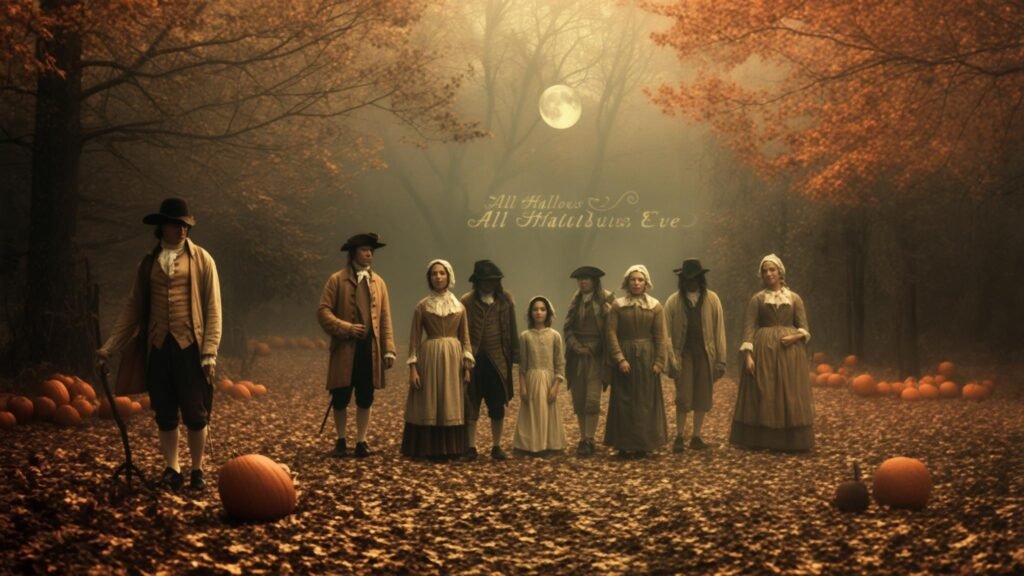
Mischief Night, Guising, and Ghost Stories
By the late 1800s, Halloween evolved into Mischief Night, especially in urban areas. “In the early 1900s, Halloween night saw kids stirring up trouble—soaping windows, freeing farm animals, and turning outhouses upside down.”
However, as urban populations grew, communities began pushing back. Newspapers from the 1910s and ’20s are filled with editorials calling Halloween a “public nuisance” and urging reform.
Thus began the American rebranding: from unruly folk holiday to family-friendly celebration.
Community Parties & the Rise of Trick-or-Treating
By the 1930s, schools and neighborhood groups hosted Halloween parties to distract kids from vandalism. Costumes became safer and less spirit-focused—more princess than poltergeist.
The term “trick-or-treat” first appeared in print in the U.S. in the 1930s, popularized through:
Community newsletters
Women’s magazines (e.g., Ladies’ Home Journal)
Comic strips promoting safe Halloween activities
After WWII, with sugar rationing lifted, Halloween candy surged. Companies like Hershey’s, Mars, and Nestlé seized the moment—wrapping spooky branding around everything from chocolate bars to lollipops.
Commercialization and the Haunted House Boom
By the 1960s–1980s, Halloween had fully merged with capitalism:
Costume stores opened seasonally
Greeting card companies like Hallmark cashed in
Haunted attractions became annual fundraising events for fire stations, churches, and schools
By the 2000s, big-box retailers like Walmart, Spirit Halloween, and Target transformed Halloween into a consumer ritual. Yard skeletons, animatronic witches, and fog machines became the new norm.
Even lawn decorations now reflect the dark origin of Halloween in humorous or exaggerated ways: 12-foot skeletons, zombie babies, or grim reapers lounging in lawn chairs.
How Pop Culture Cemented Halloween in the U.S.
American media played a pivotal role in reshaping the holiday’s meaning. Consider these key moments:
“In 1952, Disney released Trick or Treat, a playful animated short featuring Donald Duck and his mischievous nephews on Halloween night. Decades later, in 1978, John Carpenter’s horror classic Halloween redefined the genre—fueling a wave of slasher films and cementing October 31 as a staple of cinematic fear.”
1990s: Sitcoms (e.g., The Simpsons, Friends, Roseanne) dedicate annual Halloween specials
Today: TikTok’s #HalloweenDecor and #CostumeIdeas pull in billions of views
Halloween by the Numbers (U.S. Stats)
According to the National Retail Federation (NRF):
$12.2 billion was spent on Halloween in 2024 (up from $10.6B in 2022)
Over 70% of Americans participate in Halloween activities
“Each year, the average American family spends between $100 and $150 on Halloween essentials like costumes, candy, and decorations.”
Clearly, Halloween today is more than a spooky night—it’s a cultural spectacle that fuses capitalism, community, and creativity.
Do Halloween Symbols Have a Dark Meaning? Ghosts, Skulls & Jack-o’-Lanterns Explained
Does Halloween have a dark meaning, or are we just reading too much into plastic skeletons and pumpkin lights? The answer lies in the symbols—and how they’ve traveled through centuries, evolving from sacred rites to suburban decorations.

Halloween symbols didn’t appear randomly. They carry powerful emotional and spiritual undertones that point to one central idea: the thin line between life and death, and the human need to honor, mock, or manage it.
Jack-o’-Lanterns: More Than a Pumpkin Face
 Most people carve pumpkins for fun, but this tradition began as a form of spiritual protection. In ancient Celtic regions, people carved faces into turnips and rutabagas, believing the lanterns would guard homes from spirits wandering during Samhain.
Most people carve pumpkins for fun, but this tradition began as a form of spiritual protection. In ancient Celtic regions, people carved faces into turnips and rutabagas, believing the lanterns would guard homes from spirits wandering during Samhain.
Over time, Irish immigrants adapted this ritual to American pumpkins—but what most articles miss is this:
The carved face wasn’t just to scare spirits—it represented a spirit itself.
A decoy. A guardian. “It served as a ghostly warning sign, like a scarecrow meant for spirits instead of crows.”
Hidden Insight: Some households even spoke prayers or curses into the carved vegetable, “programming” it to act as a spiritual ward—similar to how protective charms are used in modern folk magic.
Ghosts & Skeletons: The Real Meaning Behind the Bone Show
 Does Halloween have a dark meaning when it comes to skeletons and ghosts? “Maybe—but think less haunted house and more ancestral whisper.”
Does Halloween have a dark meaning when it comes to skeletons and ghosts? “Maybe—but think less haunted house and more ancestral whisper.”
Ghosts were originally welcomed, not feared.“During Samhain, extra seats at the feast honored those who had passed—reminding us that skeletons weren’t symbols of fear, but of family.” They weren’t morbid—they were symbols of life’s impermanence. Memento mori, yes, but also a reminder of rebirth.
Fresh Angle: In some pre-Christian societies, bones were believed to contain ancestral memory. That’s why bones of the dead were kept in homes or shrines—what we now call “creepy” was once deeply spiritual.
Candles & Bonfires: Not Just For Ambiance
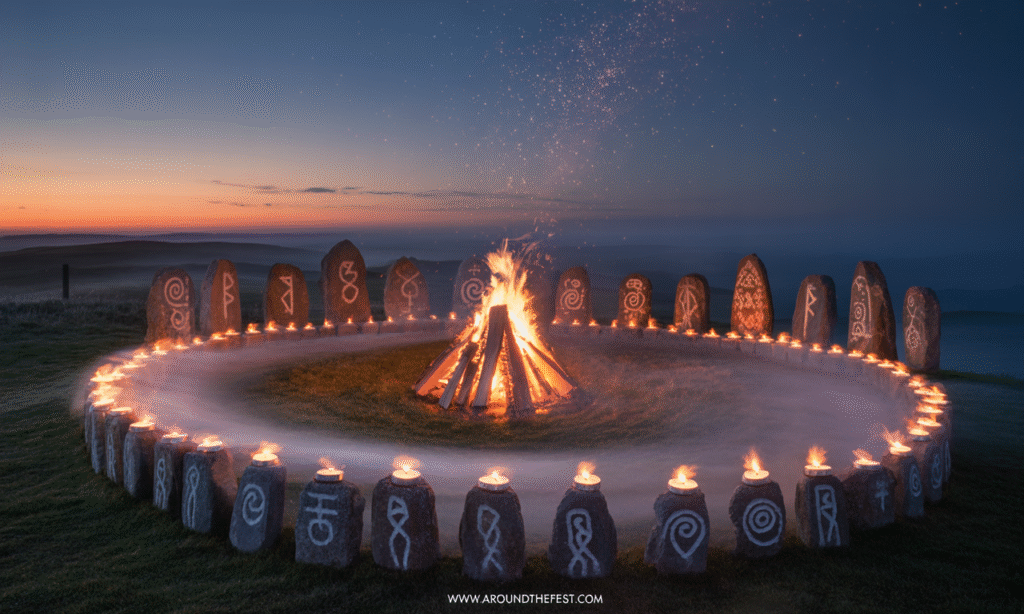 Candles on Halloween are often seen as decor. But their real function was to guide souls and repel shadow energy.
Candles on Halloween are often seen as decor. But their real function was to guide souls and repel shadow energy.
In Celtic regions, firelight wasn’t just symbolic—it was believed to anchor the living world as the spirit realm opened up. Without fire, souls could get lost—or worse, stay behind.
Lesser-Known Fact: Early bonfires weren’t random. They were lit on hilltops to reconnect fragmented soul energy of those who died violently or without burial. It was a healing ritual, not just a celebration.
Witches & Black Cats: Scapegoats or Sacred?
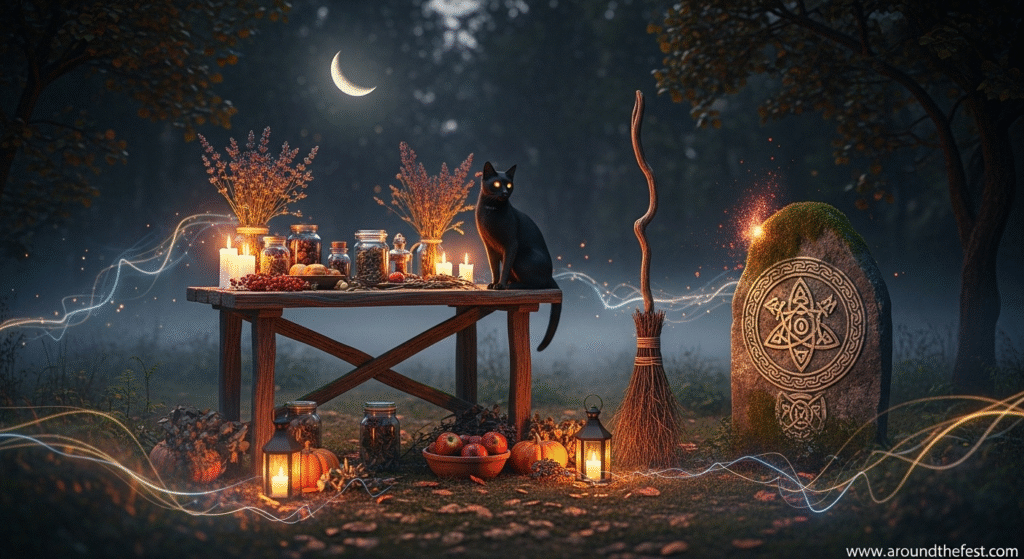 Witches are often painted as evil. But their association with Halloween comes from their role as keepers of seasonal knowledge.
Witches are often painted as evil. But their association with Halloween comes from their role as keepers of seasonal knowledge.
In agrarian cultures, the “witch” was often the midwife, herbalist, or seer—women who understood the cycles of nature. Halloween marked a time when this knowledge was needed most: harvesting, preserving, honoring the dead.
Black cats? Once seen as protectors of the home, especially during Samhain. They were believed to see what we cannot, like spirits or fate.
“Before the 15th century, ‘witch’ often meant healer or wise woman—until religious persecution recast them as evil figures in history and Halloween culture alike.” Before that, these women were respected guides between life and death.
Bats, Spiders & Owls: Natural Symbols of the Night
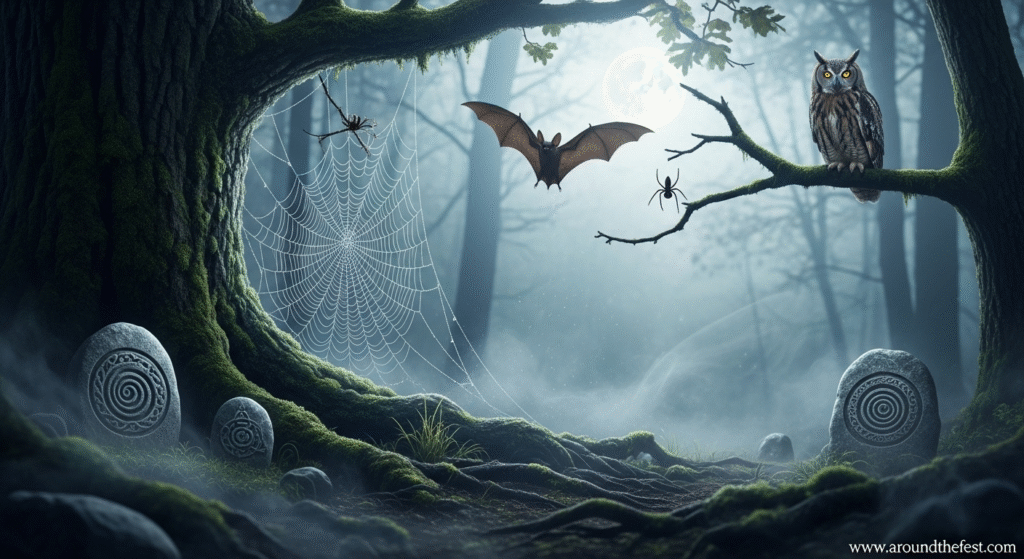 These nocturnal creatures weren’t chosen for Halloween just because they’re “creepy.”
These nocturnal creatures weren’t chosen for Halloween just because they’re “creepy.”
Bats were seen as watchers of the veil—because they can move effortlessly between light and darkness.
“Often seen as mystical weavers, spiders were linked to destiny and time, much like the three Fates in Greek mythology.”
Owls, often feared for their screech, were known to signal the presence of spirits in many ancient cultures, especially in Indigenous and African traditions.
Unique Insight: Some Native American tribes saw owls as keepers of ancestral truth, and hearing one on Samhain night was considered a sacred sign—not a curse.
Candy & Costumes: The Psychology Behind the Play
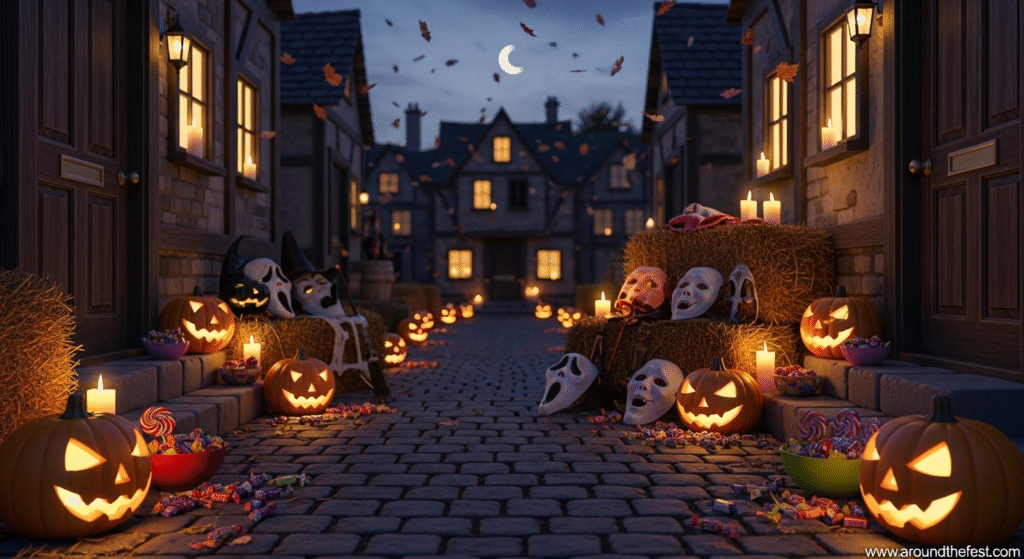 Modern candy culture seems far removed from ancient rituals. But even here, there’s a deeper layer.
Modern candy culture seems far removed from ancient rituals. But even here, there’s a deeper layer.
Costumes began as camouflage to avoid being noticed by spirits. Treats were once offerings—not for kids, but for the dead.
What no one tells you: Trick-or-treating originated not just from Christian souling but from a pagan ritual of energy exchange. When you gave someone food, you symbolically ensured peace with the other world.
Modern Application: Today’s candy-giving still echoes this theme—we “appease” the playful spirits (kids) with sugar. But the act, at its root, is about balance and generosity in the face of the unknown.
So… Does Halloween Have a Dark Meaning?
Yes—if you define “dark” as deep, reflective, and spiritually complex.
No—if you only focus on the costumes and candy.
Halloween’s symbols reflect our ancient attempts to navigate fear, honor change, and connect with something beyond the physical world. Whether you see that as eerie or empowering is up to you.
Is Halloween Evil or Just Misunderstood? Exploring Its Dark Image in Media and Myths
“It’s fun, festive, and everywhere—but Halloween remains clouded by myths and misconceptions.”
Every October, headlines resurface warning parents about poisoned candy, satanic cults, or “demonic celebrations.” But how much of this is actually true?
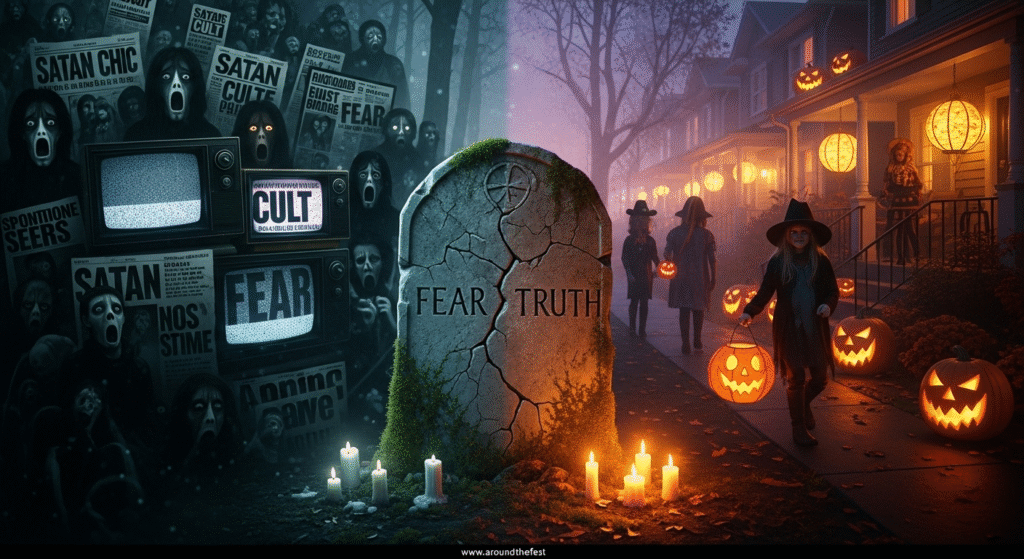
Myth 1: Halloween Is Satanic
Does Halloween have a dark meaning tied to Satanism? For many, that’s a fear—especially in some conservative or religious circles. But historical and theological analysis says otherwise.
Halloween’s roots are pagan (Samhain), not satanic.
Satanism as a concept didn’t even exist during early Celtic times.
Most accusations stem from the Satanic Panic of the 1980s and ’90s, when talk shows and news segments sensationalized rumors of ritual abuse and cult activity.
Real Insight: Multiple FBI investigations during that era found no verified cases of ritual abuse tied to Halloween. Yet, the fear persists—fueled more by cultural anxiety than evidence.
Myth 2: Kids Get Poisoned Candy or Razor-Blade Apples
This fear emerges every year, yet there’s no statistical data proving it’s a widespread threat.
According to Joel Best, a sociologist who studied Halloween poison rumors since the 1980s, there hasn’t been a single confirmed case of a stranger harming a child through Halloween candy.
Why the myth lives on: It plays into primal parental fears—strangers, children, and trust. But the reality is that most Halloween injuries come from tripping on costumes or poor visibility, not bad candy.
Myth 3: Channeling the Dark Side Through Costumes – Fact or Fear?
Some faith-based communities believe wearing costumes that resemble dark forces opens people to spiritual harm.
But this interpretation ignores the original purpose of Halloween disguises: spiritual protection. Costumes weren’t worn to glorify evil—they were worn to hide from it.
Original Context: Celts believed spirits walked freely during Samhain. Disguises were camouflage—not invitations.
Myth 4: Halloween Encourages Crime or Violence
While movies and media often link Halloween with lawlessness, the data says otherwise.
According to the National Crime Victimization Survey (2022), violent crimes don’t spike significantly on Halloween night. Petty vandalism might rise, but it’s usually teen mischief, not malicious intent.
What’s more? Many cities now schedule Halloween events early to increase safety and reduce rowdy behavior.
Deeper Truth: Why These Myths Persist
So, why does Halloween draw this level of scrutiny?
Sociologists argue that Halloween becomes a cultural battleground where we project fears about youth, rebellion, and death. It’s the one holiday that mocks taboos—and some find that threatening.
Psychologists suggest that moral panics often peak when society is undergoing cultural shifts. During times of uncertainty (economic, political, spiritual), we cling to control—and Halloween feels unpredictable.
Spiritual vs. Occult – What Religious Beliefs Say About Halloween’s Dark Side
Does Halloween have a dark meaning in the eyes of religion? That depends entirely on the lens you’re looking through.
While some faith-based communities see it as a harmless tradition of dress-up and candy, others perceive Halloween as spiritually dangerous—or even demonic. On the flip side, alternative spiritual groups like Wiccans or Neo-Pagans celebrate it as a sacred festival. The divide reveals just how complex Halloween’s spiritual identity has become.
Christian Views: Between Caution and Celebration
Concerned Christians often cite biblical scriptures that warn against engaging with spirits or the occult. Verses like Deuteronomy 18:10–12 are frequently referenced to argue that Halloween glorifies darkness, witchcraft, or death.
Many churches discourage Halloween altogether, promoting Harvest Festivals or Trunk-or-Treat alternatives that focus on community, light, and safety. These events offer costumes and candy without ghosts, devils, or witches—sidestepping the holiday’s darker imagery.
But not all Christian denominations oppose Halloween.
In 2024, The Guardian reported a viral story of a UK vicar who held a Halloween service that welcomed witches and vampires to church. His goal? To connect with younger generations by meeting them in the culture—not alienating them from it.
His approach echoes a rising movement among some Christians to reinterpret Halloween as a celebration of spiritual victory over fear and death, rather than a glorification of evil.
Neo-Pagan & Earth-Based Beliefs: Halloween as Sacred
For many Wiccans, Druids, and spiritual naturalists, Halloween (or Samhain) remains a holy time of reflection, reverence, and ritual. It marks the thinning of the veil between worlds and offers a chance to honor ancestors, grieve lost loved ones, and embrace seasonal transitions.
In these communities, Halloween isn’t dark in a negative sense—it’s spiritually deep, tied to nature, death, and rebirth.
Wiccan practitioners often use this time for personal rituals, altar-building, meditation, and candle ceremonies—not for costumes or candy.
This perspective is often missing in mainstream media portrayals of Halloween, yet it’s a growing global practice—especially among Millennials and Gen Z exploring eco-spirituality and non-institutional belief systems.
Beyond the West: Other Faith Perspectives
Other religions engage with Halloween differently—or not at all:
Islam: Generally does not celebrate Halloween due to its pagan roots and themes of death or the supernatural. However, some Muslim families may allow participation for social inclusion, especially among kids in school.
Judaism: Halloween is not a traditional Jewish holiday. Observant families may avoid it, though secular Jewish households in the U.S. often participate in a cultural, non-religious way.
Hinduism, Buddhism, Sikhism: These faiths do not have theological connections to Halloween, but views range from disinterest to acceptance of it as a secular Western tradition.
What Halloween Means Today – Culture, Community, and Controversy
Does Halloween have a dark meaning in 2025? For some, yes—but for others, it’s pure creative fun. Modern Halloween reflects a complex blend of ancient ritual, pop culture, spiritual interest, and neighborhood bonding.

For Kids: Play Over the Paranormal
For children, Halloween is light-hearted:
Dressing up as superheroes or animals
Collecting candy door-to-door
Attending school parades or community events
Many schools now favor harvest themes or “storybook character days” to avoid spooky or controversial topics.
For Adults: Nostalgia & Escape
Adults embrace Halloween as a chance to:
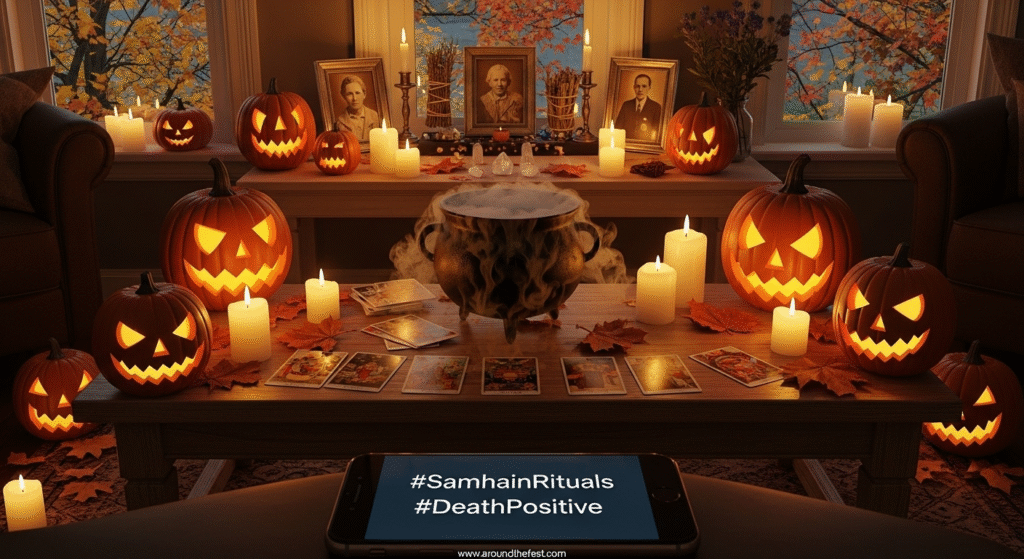
Reconnect with childhood traditions
Host themed parties or visit haunted houses
Explore deeper meanings like Samhain or ancestral rituals
In 2024, TikTok saw spikes in searches for #SamhainRituals and death-positive content, showing how Millennials and Gen Z are finding spiritual renewal in Halloween.
For Communities: Identity + Economy
Halloween boosts local economies through:
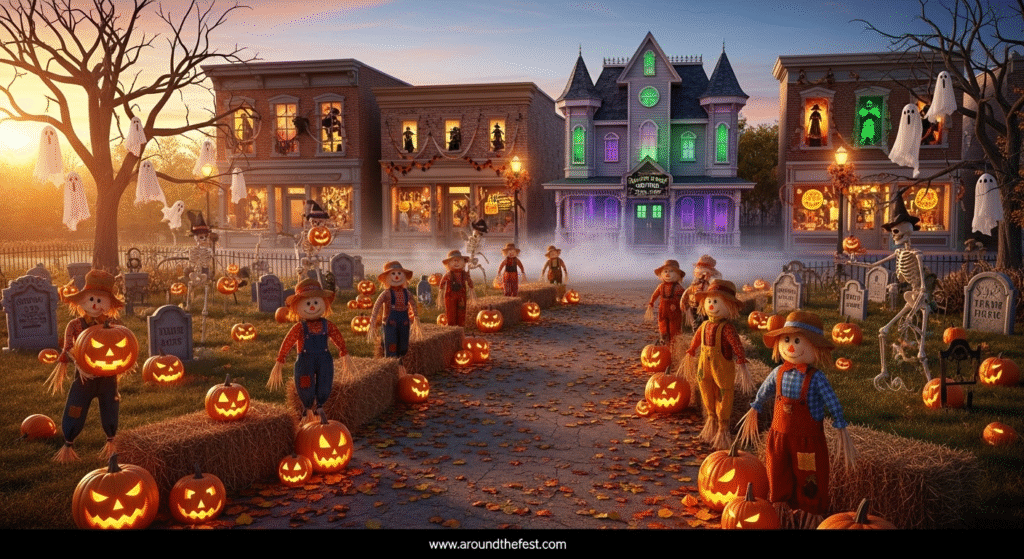
Haunted houses and themed pop-ups
Pumpkin patches and scarecrow trails
Community parades and décor contests
According to the National Retail Federation, Americans spent $12.2 billion on Halloween in 2024.
Death, But Make It Playful Symbols like skeletons, ghosts, and gravestones let people engage with death in safe, symbolic ways. For many, that’s cathartic—especially in a world still recovering from grief and uncertainty.
So, Does Halloween Have a Dark Meaning?
Yes—but also light, laughter, and layered meaning. Halloween is what you make it: ancient, fun, spiritual, or spooky. The key lies in personal perspective—not just history.
Dark Meaning of Halloween vs. Spiritual Celebrations Like Day of the Dead
Does Halloween have a dark meaning—or is it just one of many ways humans connect with the dead? Across cultures, honoring the departed looks very different:
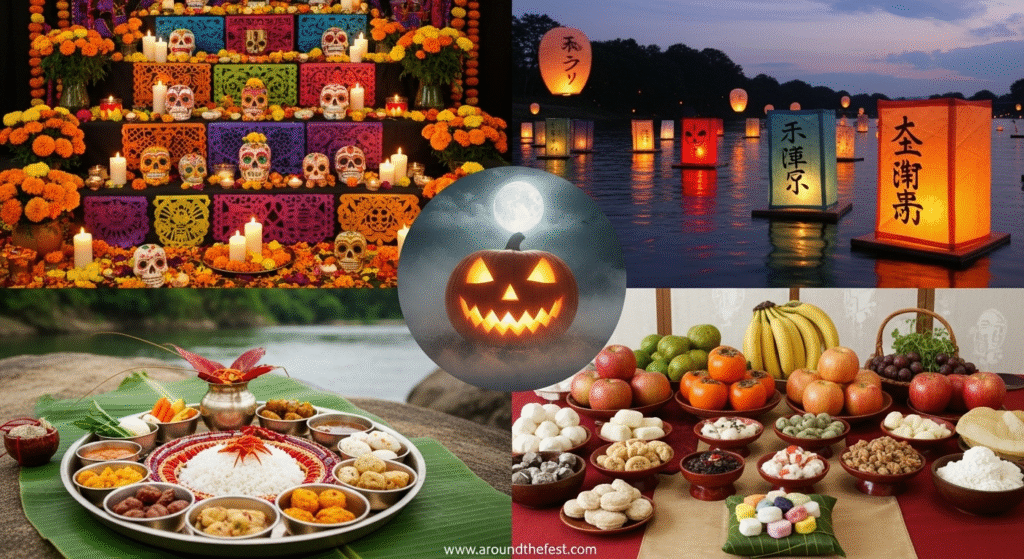 🇲🇽 Día de los Muertos (Mexico): A joyful, colorful remembrance with altars, sugar skulls, and family gatherings. “People welcome spirits, not fear them.”
🇲🇽 Día de los Muertos (Mexico): A joyful, colorful remembrance with altars, sugar skulls, and family gatherings. “People welcome spirits, not fear them.”
🇯🇵 Obon (Japan): Lantern-lit graves and meditative dances honor ancestors. Less fright, more reflection.
🇮🇳 Pitru Paksha (India): A karmic, spiritual ritual where families offer food to ancestors over 16 days, emphasizing duty and sacred continuity.
🇰🇷 Chuseok (South Korea): A harvest-based festival rooted in gratitude, tomb visits, and family meals—not ghosts or costumes.
Key Takeaway:
Compared to these spiritual and family-centered festivals, Halloween blends play, fear, and commercialism—but still reflects ancient ideas of death, transition, and connection.
Is Halloween Dark, Fun, or Just Misunderstood?
Does Halloween have a dark meaning? The answer depends on where—and how—you look.
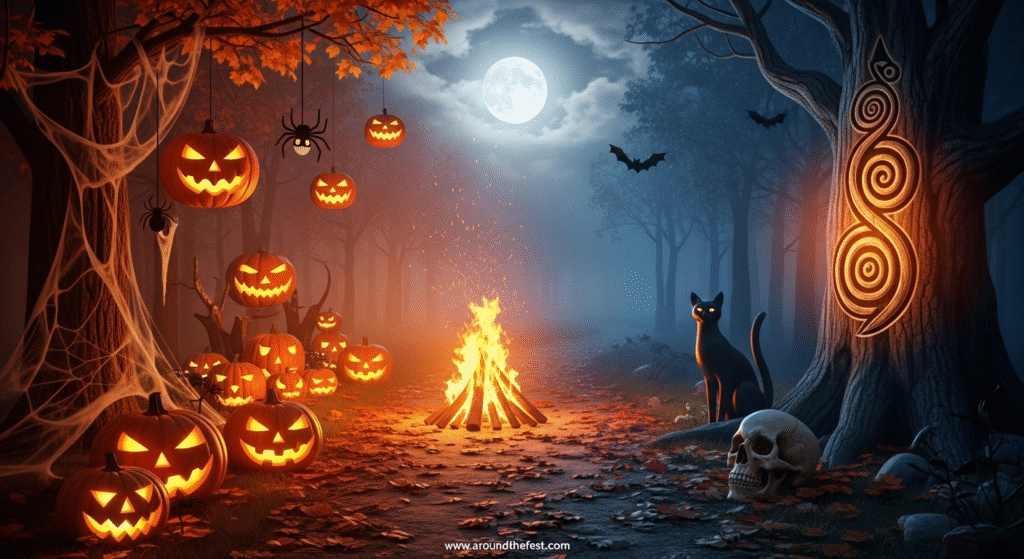 “Even today, Halloween echoes its ancient roots—honoring the dead, acknowledging mortality, and marking the thinning of the veil between worlds.” For some, it’s sacred. For others, it’s problematic or “too dark.” And yet, many embrace it as a creative, cultural outlet.
“Even today, Halloween echoes its ancient roots—honoring the dead, acknowledging mortality, and marking the thinning of the veil between worlds.” For some, it’s sacred. For others, it’s problematic or “too dark.” And yet, many embrace it as a creative, cultural outlet.
Let’s break it down:
Yes, Halloween has a dark origin—but that darkness isn’t evil; it’s symbolic, seasonal, and rooted in ancient respect for death.
No, it’s not inherently satanic—media and cultural fears have often exaggerated its meaning.
“Yes, people often misunderstand it—religious groups tend to over-vilify it, while pop culture over-commercializes it.”
And yes, it’s fun—a time to play, reflect, connect, and honor both tradition and imagination.
FAQ: Does Halloween Really Have a Dark Meaning or Not?
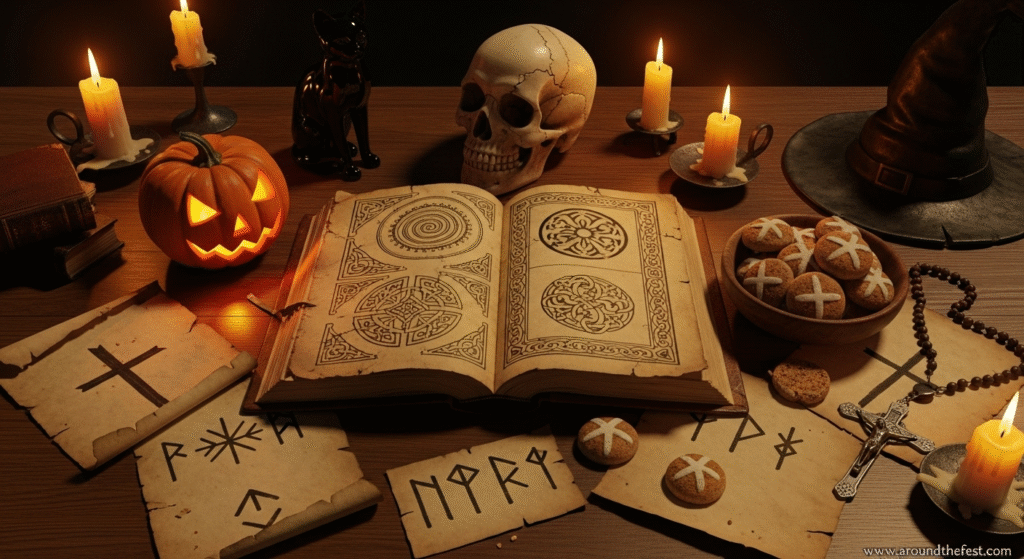 Q1: Is Halloween based on Satanic practices?
Q1: Is Halloween based on Satanic practices?
Ans: “No, historians do not consider Halloween to be rooted in Satanism.” Its dark meaning stems from ancient Celtic and Christian traditions—not satanic worship. Fears peaked during the 1980s Satanic Panic, but claims like razor blades in candy or ritual abuse were largely media-driven hoaxes.
Q2: Can Christians celebrate Halloween despite its dark themes?
Ans: It depends on the denomination. Some Christians cite Deuteronomy 18:10–12 to avoid Halloween due to its supernatural themes. Others reinterpret it through Harvest Festivals or Trunk-or-Treats, focusing on light, community, and even outreach.
Q3: What is Samhain and why is it key to Halloween’s dark origin?
Ans: Samhain (pronounced “Sow-in”) is the ancient Celtic festival that heavily influenced Halloween. Celebrated October 31–November 1, it marked the thinning veil between the living and dead. Bonfires, costumes, and ancestor offerings were all part of the original rites.
Q4: Do Halloween symbols have occult or dark meanings?
Ans: Yes—and no. Symbols like ghosts, witches, skulls, and black cats began as folk representations of death, fear, or the unseen. But today, their use is mostly secular and decorative. While rooted in folklore, their modern meaning is about fun, not ritual.
Q5: Why do people still ask, “Does Halloween have a dark meaning?”
Ans: Because Halloween’s imagery—skeletons, tombstones, spirits—suggests death and the unknown. Add religious warnings and horror movies, and the perception of darkness sticks. But historically, Halloween evolved from honoring the dead and seasonal change, not promoting evil.
Final Thoughts: Does Halloween Still Have a Dark Meaning or Just Misunderstood?
Halloween walks a line between shadow and celebration. Its roots in Samhain honor death and seasonal change, while Christianity reframed it as a sacred eve. “Today, costumes, candy, and creativity wrap Halloween—and it still stirs spiritual debate.”

Is it dark? Fun? Misunderstood?
It’s all three.
Halloween blends fear with fun, ritual with revelry. More than anything, it reflects how we process mortality, mystery, and memory—with masks on and lanterns lit.

